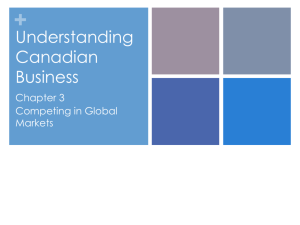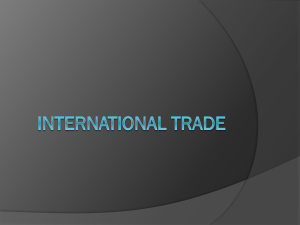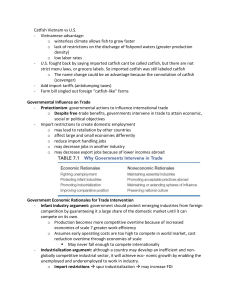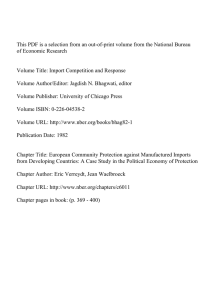The United States & the Global Economy Chapter 5 Eco 2013
advertisement
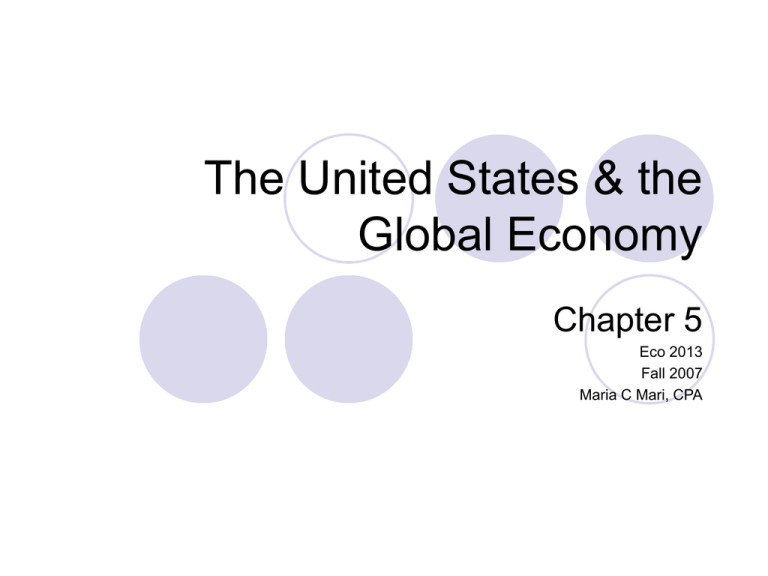
The United States & the Global Economy Chapter 5 Eco 2013 Fall 2007 Maria C Mari, CPA International Linkages Good and Services Capital and Labor U.S Economy Information & Technology Money Other National Economies Imports – 16% of domestic output Export – 11% of output Competition with other countries Trade Patterns Trade deficit Imports > exports Trade Surplus Imports < Exports Rapid Trade Growth Transportation technology Communications technology Law of Comparative Advantage States that the individual, firm, region, or country with the lowest opportunity cost of producing a particular good should specialize in that good Produce what has LOW opportunity cost Trade for what has HIGH opportunity cost Absolute Advantage Absolute: The ability to produce something using fewer resources than other producers use Comparative The ability to produce something at a lower opportunity cost than other producers face. Absolute advantage focuses on who uses the fewest resources but comparative advantage focuses on what else those resources could have produced. Foreign Exchange Market Buyers, sellers use money to buy products Different currencies Exchange rates are equilibrium prices Foreign Exchange Rate Dollar price of foreign currenc y rises Equals Equals Foreign currenc y price of dollar falls Internationa l \value of the dollar falls Equals Equals Internatio nal value of foreign currency rises Government and Trade Protective tariffs Are excise taxes or duties placed on imported goods Import quotas Limits on the quantities or total value of specific items that may be imported Non-tariff barriers Export subsidies Multilateral Trade Agreements Trade war When one nation enacts barriers against imports The nations whose exports suffer may retaliate with other trade barriers Reciprocal Trade Agreements Act Started the downward trend of tariffs Negotiating authority President is authorized to negotiate Contingent on the actions of other nations Generalized reductions Specific tariff reductions negotiated between the US and any particular nation were generalized through the most-favored nation clause. GATT Three principles Equal, nondiscriminatory trade treatment for all member nations Reduction of tariff by multilateral negotiations Elimination of import quotas World Trade Organization Established in 1995 149 nations including China Oversees trade agreements reached by the member nations Rules trade disputes among them Provides forum for trade talks European Union (EU) Free trade zone Started in 1958 Called Common Market Abolished tariffs and import quotas Liberalized the movement of capital and labor EURO EU as of 1/1/07 Austria Belgium Bulgaria Cyprus Czech Republic Denmark Estonia Finland France Germany Greece Hungary Ireland Italy Latvia Lithuania Luxembourg Malta Netherlands Poland http://europa.eu/abc/history/index_en.htm Portugal Romania Slovakia Slovenia Spain Sweden United Kingdom European Union The six founders are Belgium, France, Germany, Italy, Luxembourg and the Netherlands. Founded in 1950 Denmark, Ireland and the United Kingdom join the European Union on 1 January 1973, raising the number of member states to nine. In 1987 the Single European Act is signed. This is a treaty which provides the basis for a vast six-year program aimed at sorting out the problems with the freeflow of trade across EU borders and thus creates the ‘Single Market’. In 1993 the Single Market is completed with the the 'four freedoms' of: movement of goods, services, people and money. European Union The European Union (EU) is a family of democratic European countries, committed to working together for peace and prosperity. It is not a State intended to replace existing States, nor is it just an organization for international cooperation. The EU is, in fact, unique. Its member states have set up common institutions to which they delegate some of their sovereignty so that decisions on specific matters of joint interest can be made democratically at European level. How is it organized? The European Parliament The Council of the European Union The European Commission The Court of Justice The Court of Auditors The European Economic and Social Committee The Committee of the Regions The European Central Bank The European Investment Bank NAFTA US, Canada and Mexico Greatly reduced tariffs and other trade barriers Globalization Integration of industry, commerce, communication, travel and culture among the world’s nations.


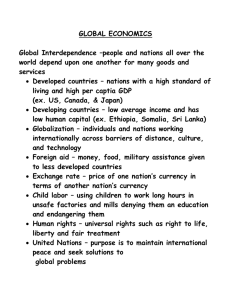

![Quiz About [Your Topic]](http://s3.studylib.net/store/data/009237721_1-467865351cf76015d6a722694bb95331-300x300.png)
